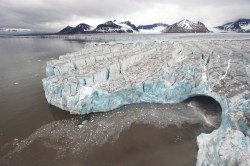
ShutterstockAs glaciers melt, they are revealing old tunics and bodies and stuff.
As glaciers melt and recede, they are revealing archaeological treasures from the civilizations that came before ours.
A humble tunic found at a site normally covered over with ice in south Norway is among the discoveries that wouldn’t have been possible without the assistance of global warming.
“It’s worrying that glaciers are melting but it’s exciting for us archaeologists,” Lars Piloe, a Danish archaeologist who works on Norway’s glaciers, said at the first public showing of the tunic, which has been studied since it was found in 2011. …
The 1991 discovery of Otzi, a prehistoric man who roamed the Alps 5,300 years ago between Austria and Italy, is the best known glacier find. In recent years, other finds have been made from Alaska to the Andes, many because glaciers are receding.
The shrinkage is blamed on climate change, stoked by man-made emissions of greenhouse gases from burning fossil fuels.
The archaeologists said the tunic showed that Norway’s Lendbreen glacier, where it was found, had not been so small since 300 AD. When exposed to air, untreated ancient fabrics can disintegrate in weeks because of insect and bacteria attacks.
Well, old tunics are cool. Nobody is saying they’re not. But it’s too bad we can’t dig up some of the wisdom of past societies that treasured nature and valued lives lived in harmony with it. Alongside the smelly old clothes, of course.




